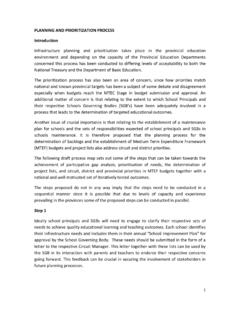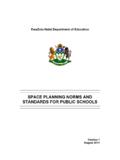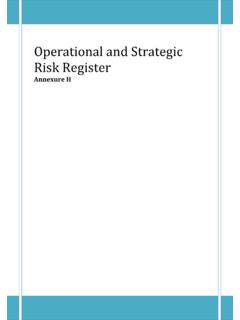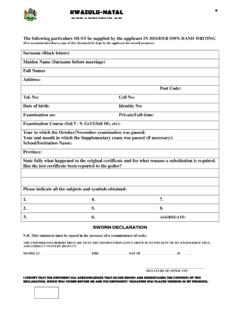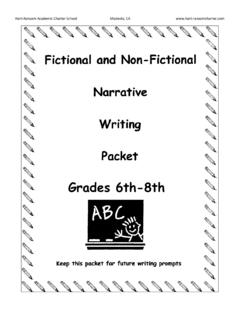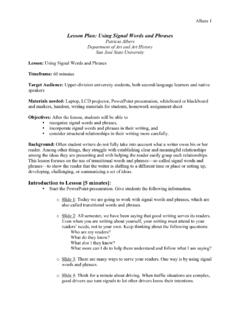Transcription of GUIDELINE FOR TEACHING AND WRITING ESSAYS AND ...
1 GUIDELINE FOR TEACHING AND WRITING ESSAYS AND TRANSACTIONAL TEXTS English Grades 10 - 12 Home language Fist Additional Language Second Additional Language 2 CONTENTS TYPE OF TEXT PAGE 1. Introduction 4 2. Process WRITING 4 3. ESSAYS : Kinds of ESSAYS 5 Narrative essay 5 Descriptive essay 6 Expository essay 6 Argumentative essay 7 Discursive essay 7 Reflective essay 8 4. Transactional WRITING Longer Transactional Texts 9 Official letter 9 Friendly letter 11 Internal Memorandum 12 WRITING a short article 15 Agenda and minutes of the meeting 15 Speech 18 Dialogue 19 Interview 20 Review 21 Newspaper article 22 Magazine article 23 Newspaper column 24 Curriculum Vitae (CV) 25 Obituary 27 Brochure 28 Editorial 29 3 Shorter Transactional Texts 30 Invitation 30 Diary 31 Post card 32 Direction 32 Instructions 34 Advertisement 34 Flyer 35 Poster 36 Filling in a form 38 WRITING an email 38 Sending a Fax 40 4 1.
2 INTRODUCTION The purpose of this GUIDELINE is to briefly guide teachers and learners on the aspects of WRITING and presenting. Furthermore, the GUIDELINE presents and shares information with regards to producing various texts and their uses. This will enable learners to attain and successfully demonstrate Learning Outcome 3 (LO 3), which aims to ensure that The learner is able to write and present for a wide range of purposes and audiences using conventions and formats appropriate to diverse contexts. This GUIDELINE may be used by teachers and learners of English Home, First and Second Additional Languages. The document will also enable learners to prepare for the WRITING Paper (Paper 3) which requires learners to choose and write three of the various WRITING texts dealt with during the course of the year.
3 2. PROCESS WRITING WRITING and designing texts is a process and learners need the opportunity to put this process into practice. They should: decide on the purpose and audience of a text to be written and/or designed; brainstorm ideas using, for example mind maps, flow charts or lists; consult relevant sources, select relevant information and organise ideas; produce a first draft which takes into account purpose, audience, topic and genre; read drafts critically and get feedback from others (classmates); edit and proofread the draft; produce a well-designed final version. Note! Learners should write every day. Learners should often be given the opportunity to write freely without an assessment requirement.
4 In more formal WRITING , teachers are advised to assess a particular skill or sub-skill being dealt with during that particular stage of the process. For example, all language skills need not be addressed during each step of the process. Peers should also learn to edit one another s work as this interaction is an important part of the process of WRITING and improves own and other s awareness of the process. An important aspect of this Learning Outcome is the presentation of written work. It can be shared with peers, teachers, the school as a whole, parents and/or a wider range of stakeholders. The learner should take pride in a rounded, complete product.
5 Learners should be informed about the characteristics and requirements of different kinds of creative texts. A short description of the kinds of WRITING texts that learners are required to produce is provided below. 5 3. ESSAYS An essay is an extended piece of WRITING , in which a writer expresses his/ her point of view on the topic given. The length of texts ranges from: 200 250 words for English Second Additional Language; 250 300 words for English First Additional Language; and, 400 450 words for English Home Language. An essay should have an introduction, body and conclusion. A brief explanation of each follows: Introduction The introduction should catch the reader s attention, define the topic and briefly tell the reader what the essay will be addressing.
6 Body The body comprises the full content of the essay. The body must be divided into paragraphs, each of which must pursue a specific idea to the end. The writer must address all the ideas he or she wanted to address, keeping to the topic. Conclusion The conclusion is the ending, the rounding-off of the presentation. This should tie up all that was presented by the writer, a parting shot that justifies the writer s point of view. As this is the end, the writer must not bring in new information. Learners must be taught how to write and must write - the following kinds of ESSAYS : Narrative essay A narrative essay tells a story or tells of a past event. It can be written from any perspective.
7 Example topics: We were having a wonderful time. There was good food, good music and good company. Suddenly there was an earth-shaking crash. Write about the incident. The best story my grandfather told me. Consider the following when WRITING a narrative essay: The story must have a strong story line and be convincing even if it is fiction. A narrative essay is usually written in the past tense. The introductory paragraph should capture the reader s attention. A good story often has a point to make. An unusually interesting ending gives a story the final touch. The reader s interest must be maintained until the end. The style, rhetorical devices and action must ensure sustained interest.
8 A successful narrative vividly highlights sensory details such as sight, sound, taste, smell and tactile sensations. A narrative essay often has a strong descriptive element. 6 Descriptive essay In a descriptive essay, the writer describes something to allow the reader to experience the topic being described as vividly as possible. Someone or something can be described. Example topics: The dentist s waiting room. Describe your feelings and impressions. Describe a stormy night. Consider the following when WRITING a descriptive essay: The writer should create a picture in words. Words and expressions are chosen carefully to achieve the desired effect. Images of sight, sound, hearing, taste and touch can be used to make the description vivid.
9 Figures of speech are used in original ways. Learners should ideally have experience of the topic. It is very difficult to describe something without having firsthand knowledge. Expository essay Expository WRITING communicates ideas or information in a logical way. This is a factual essay in which the writer explains ideas or gives facts in a systematic way. An expository essay is well researched and ideas are supported by facts and figures. Example topics: More than a thousand people are killed in road accidents during the December holiday. How can this carnage on our roads be stopped? Discuss how you would go about collecting funds for the matric farewell party. Consider the following when WRITING an expository essay: A thorough understanding of the topic is required.
10 Good research is vital as statements have to be supported by facts. As the reader may not have a specialised understanding of the topic, the writer should clarify any concepts which may be unfamiliar. Ideas must be organised logically and take the reader from the known to the unknown. An expository essay is generally written in the present tense. 7 Argumentative essay In an argumentative essay, the writer has a specific opinion or viewpoint and argues to defend or motivate his or her position. The opinion of the writer should be clear throughout. This is a subjective essay in which the writer tries to convince the reader to share his or her point of view. Examples topics: Television kills creativity.
